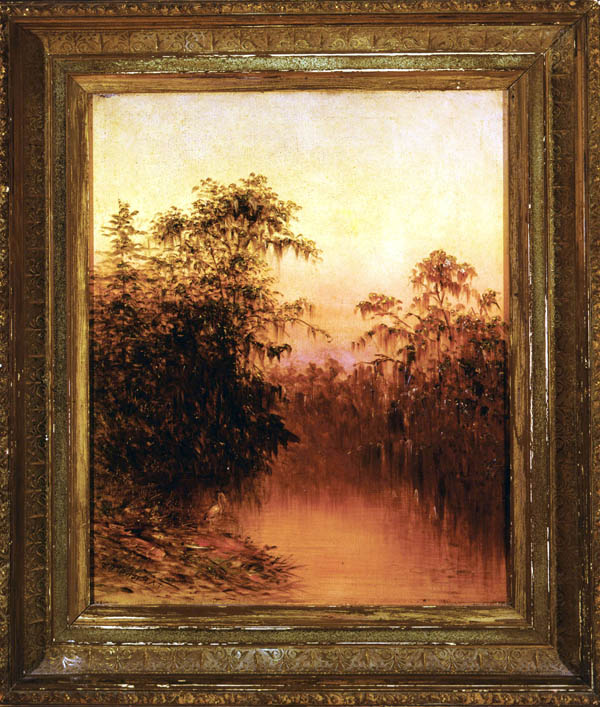Thomas Addison Richards
Artist and travel writer Thomas Addison Richards captured unique natural features of the South, depicting the region's lofty river banks, picturesque live oaks, and lush cypress-filled swampland.

Courtesy of Roger H. Ogden Collection
Dusk in the Swamp. Richards, Thomas Addison (artist)
Prtist and travel writer Thomas Addison Richards captured unique natural features of the South, depicting the region’s lofty river banks, picturesque live oaks, and lush cypress-filled swampland. A professionally trained artist, Richards exhibited his southern landscapes at institutions including the National Academy of Design. He was a contributor to Harper’s New Monthly Magazine, and served as editor to Appletons’ Companion Hand-Book of Travel.
Richards was born in London, England, on December 3, 1820. His parents, Ann and William Richards, moved the family to Hudson, New York, upon their arrival in the United States in 1831. After a brief stay in Charleston, South Carolina, the Richards family moved to Penfield, Georgia, in 1835. Richards then lived in Augusta, Georgia, and worked as an art teacher from 1838 to 1841. Richards and his brother William Carey published Georgia Illustrated, in a Series of Views (1842) and the magazine the Orion (1842–1844), for which Richards wrote articles that required traveling to various southern states, including Louisiana. In 1844, Richards trained at the National Academy of Design in New York City. He exhibited on numerous occasions at the Academy during his career, and in 1852 became the corresponding secretary for the institution for more than forty years.
Richards was influenced by earlier nineteenth century artists and writers such as Thomas Cole (1801–1848), who traveled and explored America’s expansive landscape, documenting and depicting the varied scenery. It is in this artistic milieu that Richards established himself as an accomplished landscape artist and travel writer in the mid-nineteenth century. Between 1846 and 1856, Richards traveled extensively throughout the North and South, completing plein air sketches, landscape paintings, and writings. His works reflected his interest in the natural environment, and particularly the southern landscape, as seen in his painting Dusk in the Swamp (ca. 1855).
Richards’s popular publications relating to the South include Tallulah and Jocassee (1852) and The Romance of American Landscape (1854). He also submitted numerous articles that appeared in Harper’s New Monthly Magazine, including “The Landscape of the South” (1853) and “The Rice Lands of the South” (1859), articles he wrote from information gleaned during his travels. His writings were accompanied by illustrations and described the lush environs found in the South. In “The Rice Lands,” Richards commented on “giant cypresses,” “forest swamps and dark lagoons,” and the rivers “in the lower parts of the Atlantic and Gulf States, [that are] of singular beauty in the hazy atmosphere, and in their gorgeous drapery of the foliage of the live and water oaks.” His paintings reflected his written descriptions, as in his picturesque landscape painting River Plantation.
The artist served as editor for the popular and comprehensive guidebook Appletons’ Companion Hand-Book of Travel (1857; 1862). This was the first complete guidebook of America and Canada, and was “bound with pliable cloth sides, so as to be convenient for the traveller.” It provided the enthusiastic tourist with detailed information on lodgings and important landmarks, and was accompanied by varied illustrations. The 1862 edition includes a chapter dedicated to the state of Louisiana. It mentions such landmarks as the “palatial” St. Louis Hotel, the markets, cemeteries, and New Orleans’s Jackson Square, “a place of favorite resort…its shell-strewn paths, its beautiful trees and shrubbery, and its statuary, are all agreeable pleasures to enjoy.”
In 1858, Richards married Mary E. Anthony, a children’s book author. He was appointed the first director of the Cooper Union School of Design for Women from 1858 to 1860. The artist remained in New York during the Civil War and was appointed professor at New York University in 1867, where he taught until 1887. In addition to exhibiting at the National Academy, he exhibited at the Brooklyn Art Association. Richards died in Annapolis, Maryland, on June 28, 1900.
